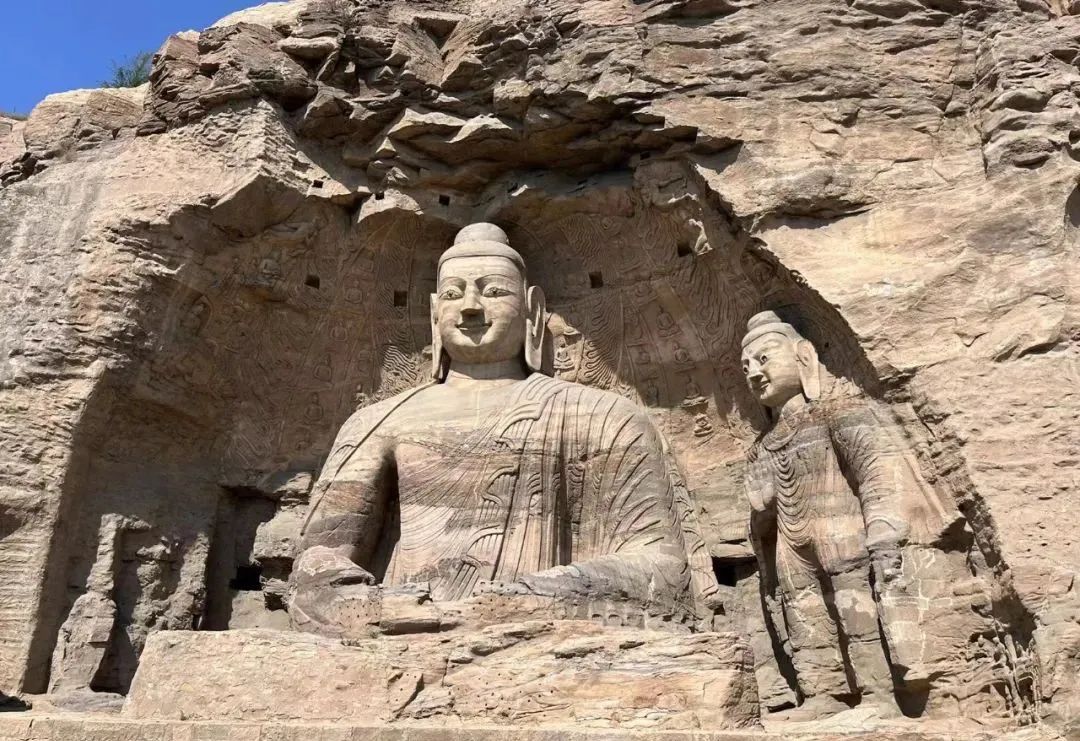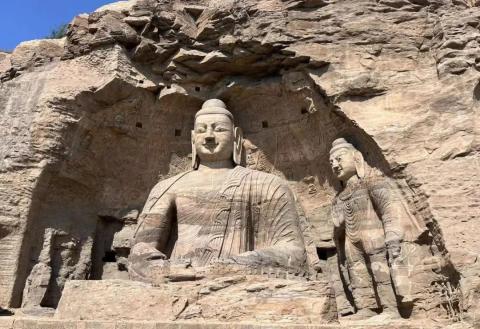
Today is September 28th. The last day of our trip to Shanxi. After planning to visit Huayan Temple, Yungang Grottoes and Shahukou, we rushed directly to Taiyuan Wusu Airport and flew back to Hangzhou.However, due to the sudden positive cases of the new coronavirus in Datong and Taiyuan, the situation immediately became serious. The tense atmosphere we felt on the road has overshadowed the excitement of visiting Huayan Temple and Yungang Grottoes.The weather is still very friendly, with endless blue skies and neither too cold nor too hot. On the way, we experienced the openness and undulating wilderness of northern Shanxi .Let me first talk about my impressions of the city of Datong.When talking about Datong, the first thing that comes to mind is coal; the second is an ancient historical city. Datong originally belonged to Chahar Province. After Chahar Province was withdrawn, it was merged into Shanxi Province. At that time, the cities that were also Chahar included Zhangjiakou and Ordos. Zhang was annexed to Hebei, and Hubei was annexed to Inner Mongolia. Datong was also the capital of the Liao Kingdom in ancient times and was called Pingcheng at that time.
We arrived in Datong on the evening of the 27th. The ancient city wall along the way, under the dim lights, is like a beautiful stage showing history. After dinner, Mr. Gu took us to visit the square in front of Huayan Temple. Maybe it was too late, or maybe it was the impact of epidemic prevention and control. The square was empty, with only the colorful lights blooming alone. Judging from the outline of the building, it is quite beautiful and exquisite.
Mr. Gu said that the people of Datong greatly appreciated the former mayor Geng Yanbo. When Geng left Datong to take office in Taiyuan, more than 100,000 citizens spontaneously came to the station to see him off. Because when Geng was in office, he built Datong into an open, inclusive and stylish place that shines through the past and present. It is said that the "Secretary Da Kang" in the TV series is the prototype of Geng. Of course, Geng also used an iron fist during the massive demolition and construction. When personal interests conflict with the interests of the city, an iron fist will hit the individual mercilessly. But the people are consequentialists, and they are the lucky ones who enjoy the results. Those who are lucky will inevitably have cognitive biases.
(Geng Yanbo. Picture source from the Internet)
In the morning of the 28th, at Huayan Temple, the square in front of the temple was completely bare compared to the enchanting one last night. But some details are more prominent. For example, the street lamps designed and made with the shapes of the maids in the Yungang Grottoes are unique. I can't help but think of Deqing, which is said to be the source of porcelain, dance, pearls, and many other "sources." However, in urban cultural construction, such "source" elements are rarely seen.

(Street lamp shape in the square in front of Huayan Temple)
Huayan Temple was built in 1038 (the seventh year of Chongxi reign of Liao Dynasty). The name comes from the Buddhist classic "Huayan Sutra". Huayan Temple has the character of an ancestral temple of the Liao royal family and has a prominent status. Later it was destroyed in the war. It was rebuilt in the third year of Jin Tianjuan (1140). In the temple, more than 30 individual buildings, including the mountain gate, Pu Guangming Hall, Mahavira Hall, Bojiajiao Hall, and Huayan Pagoda, are arranged separately with a rigorous layout.
(Pu Guangming Hall of Huayan Temple)In the Pu Guangming Hall, I saw a pair of couplets, "This is enough to say that things are booming, wealth and wealth have no end; life has been so turbulent since ancient times that fame and wealth are hard to let go of." Written couplet. The signature is Geng Yanbo.Huayan Pagoda is also the work of Geng Yanbo. It is the second largest square wooden pagoda with pure wooden mortise and tenon structure in the country after the wooden pagoda Shakya Pagoda in Yingxian County, with a height of 43 meters. As I gazed at this magnificent pagoda, I sensed Geng Yanbo’s consciousness, which should be his thousand-year ambition after having experienced wealth, fame, and wealth.
It now appears that the Northern Wei Dynasty's construction of the Yungang Grottoes more than 1,500 years ago was their ambition to pass on the light of Buddha for thousands of years.Walking into the visitor center, the decoration is like a five-star hotel, elegant and beautiful, but also full of ancient charm. It’s the only one I’ve seen in a few days of travel.
Passing through the visitor center is Tan Yao Square, with 26 six-toothed elephant-backed hunchback Buddha pillars standing on both sides. According to records, the Yungang Grottoes were excavated by Emperor Wencheng in the early years of peace (460 ) upon the advice of the eminent monk Tan Yao.
( Tan On the Yao Square Tan Yao Xiang)Entering the grotto area, the grotto has been protected by a gate. Visiting the cave is like being indoors.According to legend, AD 439 Year: Emperor Taiwu Tuoba Tao Initiated a movement to abolish Buddhism. Buddhism flourished in Northern Liang, where there were numerous monks and craftsmen. ( Zhangye and Pingliang areas in present-day Gansu ) Moved eastward to Datong, the capital of the Northern Wei Dynasty. Tuoba Jun When he was in power, he promoted Buddhism and excavated Buddhist caves. since 460 to 494 It was built in 1642. It was carved into the mountain and stretches one kilometer from east to west. 45 Statue of different sizes 59000 Yu Zun, the tallest statue 17 Meters, minimum 2 Centimeters. Before all the Buddhist caves were completed, the Wei Dynasty moved its capital to Luoyang. Thus, the Longmen Grottoes in Luoyang were built.
Mr. Gu said that from the Western Regions to the Dunhuang Grottoes in Gansu, and then to the Yungang and Longmen Grottoes, the line of Buddhism spreading from west to east is clear. He said that at that time, the construction of the caves was subcontracted by the royal family and nobles. Each of them was assigned a piece and hired craftsmen to tell Buddhist stories. According to Li Daoyuan's "Shui Jing Zhu", there were as many as 100,000 builders working on Dingdingdongdong at that time.
The Yungang Grottoes are 500 years older than the Yingxian Wooden Pagoda. The Tuoba people of the Northern Wei Dynasty were also a horseback nation. Their exquisite design, layout, carving ability and level of economic development are all amazing.Mr. Gu's talk along the way attracted a group of tourists who listened.
(Mr. Gu is explaining)
Before I knew it, it was afternoon. After we saw the last scenic spot, "The Killing Tiger's Mouth", we hurried back to Taiyuan.
(At the mouth of the tiger)
In the car, sister-in-law Leping checked her cell phone."Oops, not good! There was one positive case in Datong today and two positive cases in Taiyuan." Looking at the test report this morning, the test report has not yet come out. The atmosphere suddenly became tense. I couldn't help but speed up the car, hoping to get to Taiyuan Wusu Airport as soon as possible.When we arrived at Daying Service Area, the sun was already setting. I let Xinliang, my brother who is more suitable for driving at night, take the steering wheel.There was a long queue at the entrance to the restroom, and the rules were obviously stricter. In addition to scanning the QR code, you must also show a nucleic acid test certificate. I said I did it this morning. They didn't believe it and said that they had to do nucleic acid tests before they could enter. Due to internal urgency, I had no choice but to queue up for the second nucleic acid test. At this time, two buses stopped, hundreds of people got off, and the entrance was suddenly blocked. I was pushed in involuntarily.
(Indoor entrance of Daying service area)
When I got off the expressway at Wusu hub near the airport, I saw a long queue of cars again. Cars are strictly inspected one by one. When it was our turn, we were all asked to get out of the car and go to one side to fill out a form. Then I was asked to scan the QR code to do nucleic acid testing. A carload of 5 people all have to do it. I said I had already done it this morning. And the report was out and they ignored it. I had no choice but to queue up for the third nucleic acid test. Finally, we got a note. Give the note to the staff member who stopped the car, and the officer will let you go.

(note of release)
When we arrived at Wusu Airport, it was still 5 days nucleic acid, just like when we arrived.At 22:30, the flight took off on time, leaving the starry Taiyuan where it was. The flight landed at Hangzhou Xiaoshan Airport at 24. Before leaving the terminal, I was asked to take a nucleic acid test again.On September 28, 2022, four nucleic acid tests were performed non-stop .Maybe this is the price of traveling during the epidemic control period. 
















